Analyzing the Impact of the Charter of Rights and Freedoms in Canada
VerifiedAdded on 2021/10/10
|11
|2646
|58
Essay
AI Summary
This essay provides an in-depth analysis of the Canadian Charter of Rights and Freedoms, exploring its impact on various aspects of Canadian law and policy. The introduction highlights the Charter's role in transforming the Supreme Court and the Canadian legal landscape, emphasizing the shift from interpreting law to actively shaping it. The thesis argues that the Charter has entrenched the role of judges as guardians of Canadians' rights, influencing policy decisions. The essay delves into the background of the Charter, noting its constitutional status and the judiciary's power to reject laws violating rights. It examines the Charter's impact on criminal law enforcement, including cases related to impaired driving and due process, as well as its influence on Sunday closing laws and restrictions on political action committee expenditures. The discussion analyzes specific cases, such as Oakes and Operation Dismantle, to illustrate the Charter's influence on policy decisions and interest group actions. The conclusion reinforces the Charter's significance in shaping Canadian policy, the judiciary's active role in promoting the rights of citizens, and the overall transformation of the Canadian legal system.
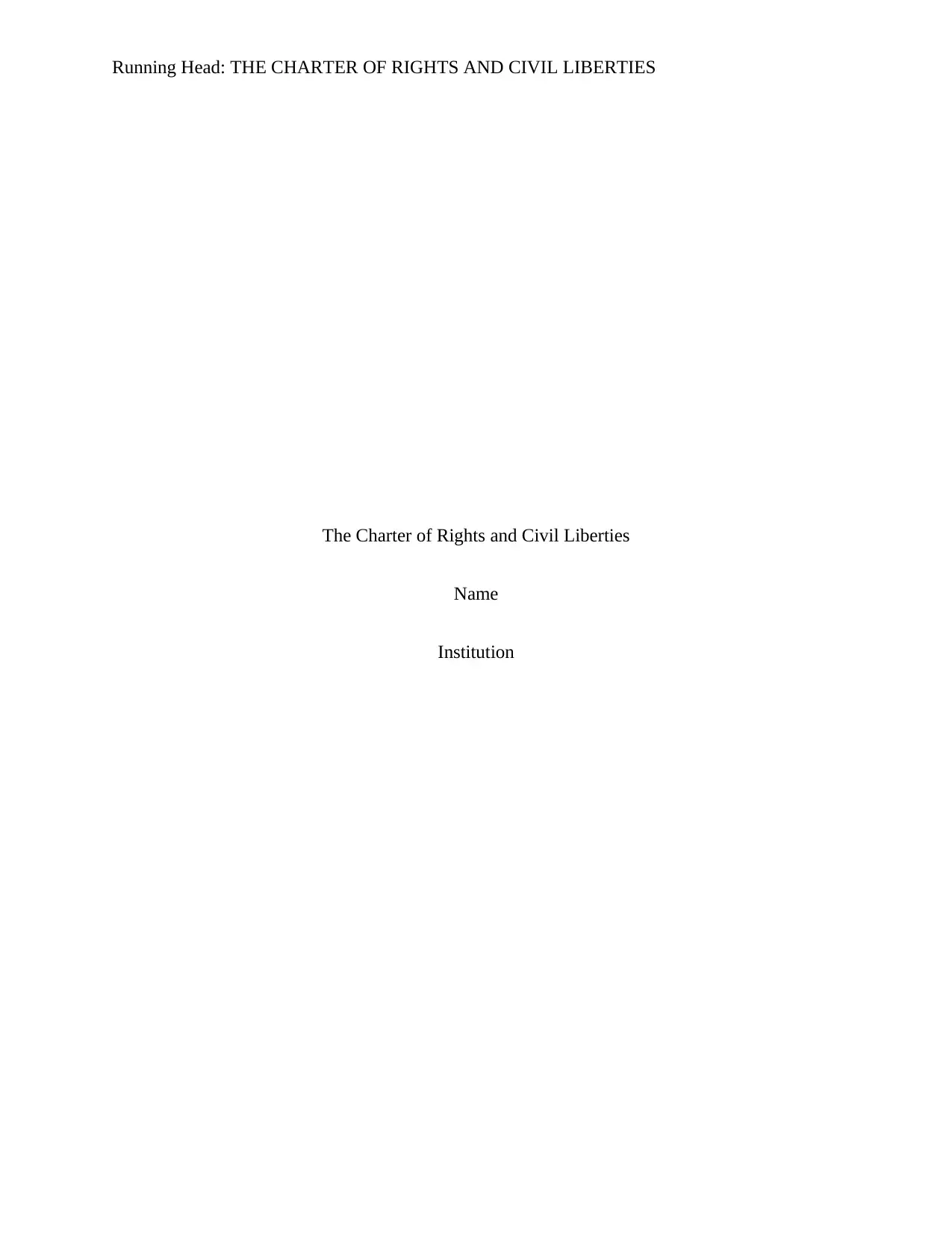
Running Head: THE CHARTER OF RIGHTS AND CIVIL LIBERTIES
The Charter of Rights and Civil Liberties
Name
Institution
The Charter of Rights and Civil Liberties
Name
Institution
Paraphrase This Document
Need a fresh take? Get an instant paraphrase of this document with our AI Paraphraser
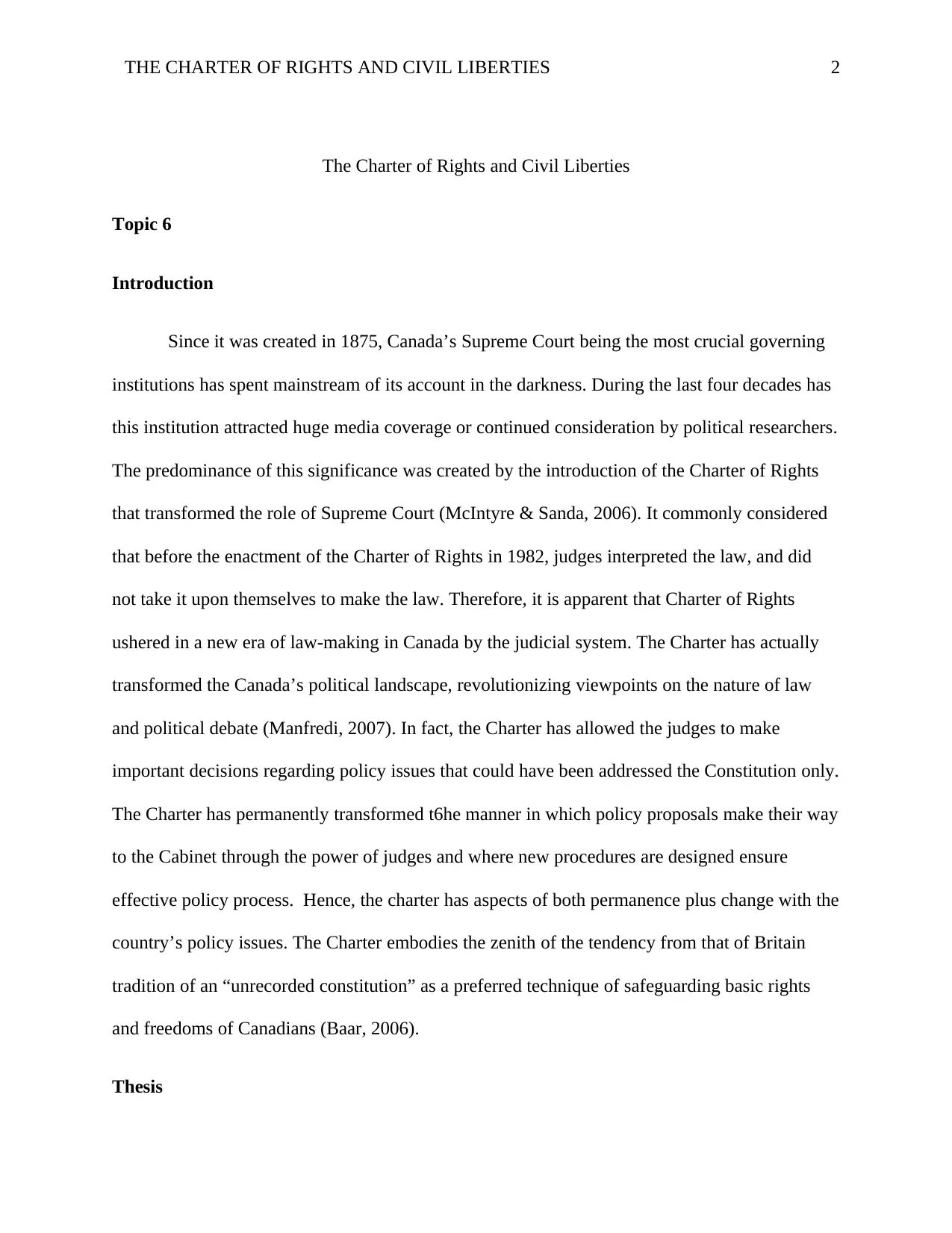
THE CHARTER OF RIGHTS AND CIVIL LIBERTIES 2
The Charter of Rights and Civil Liberties
Topic 6
Introduction
Since it was created in 1875, Canada’s Supreme Court being the most crucial governing
institutions has spent mainstream of its account in the darkness. During the last four decades has
this institution attracted huge media coverage or continued consideration by political researchers.
The predominance of this significance was created by the introduction of the Charter of Rights
that transformed the role of Supreme Court (McIntyre & Sanda, 2006). It commonly considered
that before the enactment of the Charter of Rights in 1982, judges interpreted the law, and did
not take it upon themselves to make the law. Therefore, it is apparent that Charter of Rights
ushered in a new era of law-making in Canada by the judicial system. The Charter has actually
transformed the Canada’s political landscape, revolutionizing viewpoints on the nature of law
and political debate (Manfredi, 2007). In fact, the Charter has allowed the judges to make
important decisions regarding policy issues that could have been addressed the Constitution only.
The Charter has permanently transformed t6he manner in which policy proposals make their way
to the Cabinet through the power of judges and where new procedures are designed ensure
effective policy process. Hence, the charter has aspects of both permanence plus change with the
country’s policy issues. The Charter embodies the zenith of the tendency from that of Britain
tradition of an “unrecorded constitution” as a preferred technique of safeguarding basic rights
and freedoms of Canadians (Baar, 2006).
Thesis
The Charter of Rights and Civil Liberties
Topic 6
Introduction
Since it was created in 1875, Canada’s Supreme Court being the most crucial governing
institutions has spent mainstream of its account in the darkness. During the last four decades has
this institution attracted huge media coverage or continued consideration by political researchers.
The predominance of this significance was created by the introduction of the Charter of Rights
that transformed the role of Supreme Court (McIntyre & Sanda, 2006). It commonly considered
that before the enactment of the Charter of Rights in 1982, judges interpreted the law, and did
not take it upon themselves to make the law. Therefore, it is apparent that Charter of Rights
ushered in a new era of law-making in Canada by the judicial system. The Charter has actually
transformed the Canada’s political landscape, revolutionizing viewpoints on the nature of law
and political debate (Manfredi, 2007). In fact, the Charter has allowed the judges to make
important decisions regarding policy issues that could have been addressed the Constitution only.
The Charter has permanently transformed t6he manner in which policy proposals make their way
to the Cabinet through the power of judges and where new procedures are designed ensure
effective policy process. Hence, the charter has aspects of both permanence plus change with the
country’s policy issues. The Charter embodies the zenith of the tendency from that of Britain
tradition of an “unrecorded constitution” as a preferred technique of safeguarding basic rights
and freedoms of Canadians (Baar, 2006).
Thesis
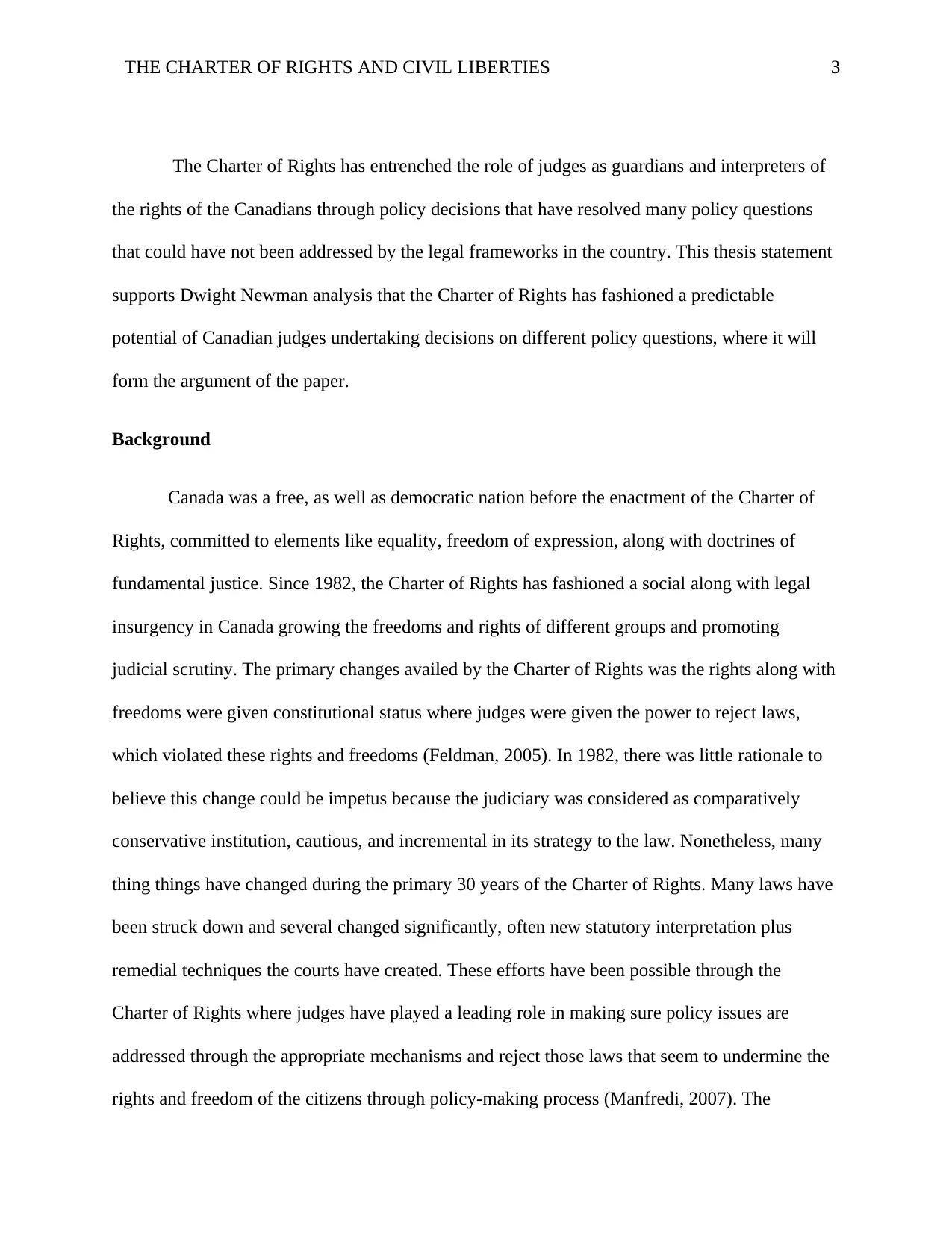
THE CHARTER OF RIGHTS AND CIVIL LIBERTIES 3
The Charter of Rights has entrenched the role of judges as guardians and interpreters of
the rights of the Canadians through policy decisions that have resolved many policy questions
that could have not been addressed by the legal frameworks in the country. This thesis statement
supports Dwight Newman analysis that the Charter of Rights has fashioned a predictable
potential of Canadian judges undertaking decisions on different policy questions, where it will
form the argument of the paper.
Background
Canada was a free, as well as democratic nation before the enactment of the Charter of
Rights, committed to elements like equality, freedom of expression, along with doctrines of
fundamental justice. Since 1982, the Charter of Rights has fashioned a social along with legal
insurgency in Canada growing the freedoms and rights of different groups and promoting
judicial scrutiny. The primary changes availed by the Charter of Rights was the rights along with
freedoms were given constitutional status where judges were given the power to reject laws,
which violated these rights and freedoms (Feldman, 2005). In 1982, there was little rationale to
believe this change could be impetus because the judiciary was considered as comparatively
conservative institution, cautious, and incremental in its strategy to the law. Nonetheless, many
thing things have changed during the primary 30 years of the Charter of Rights. Many laws have
been struck down and several changed significantly, often new statutory interpretation plus
remedial techniques the courts have created. These efforts have been possible through the
Charter of Rights where judges have played a leading role in making sure policy issues are
addressed through the appropriate mechanisms and reject those laws that seem to undermine the
rights and freedom of the citizens through policy-making process (Manfredi, 2007). The
The Charter of Rights has entrenched the role of judges as guardians and interpreters of
the rights of the Canadians through policy decisions that have resolved many policy questions
that could have not been addressed by the legal frameworks in the country. This thesis statement
supports Dwight Newman analysis that the Charter of Rights has fashioned a predictable
potential of Canadian judges undertaking decisions on different policy questions, where it will
form the argument of the paper.
Background
Canada was a free, as well as democratic nation before the enactment of the Charter of
Rights, committed to elements like equality, freedom of expression, along with doctrines of
fundamental justice. Since 1982, the Charter of Rights has fashioned a social along with legal
insurgency in Canada growing the freedoms and rights of different groups and promoting
judicial scrutiny. The primary changes availed by the Charter of Rights was the rights along with
freedoms were given constitutional status where judges were given the power to reject laws,
which violated these rights and freedoms (Feldman, 2005). In 1982, there was little rationale to
believe this change could be impetus because the judiciary was considered as comparatively
conservative institution, cautious, and incremental in its strategy to the law. Nonetheless, many
thing things have changed during the primary 30 years of the Charter of Rights. Many laws have
been struck down and several changed significantly, often new statutory interpretation plus
remedial techniques the courts have created. These efforts have been possible through the
Charter of Rights where judges have played a leading role in making sure policy issues are
addressed through the appropriate mechanisms and reject those laws that seem to undermine the
rights and freedom of the citizens through policy-making process (Manfredi, 2007). The
⊘ This is a preview!⊘
Do you want full access?
Subscribe today to unlock all pages.

Trusted by 1+ million students worldwide
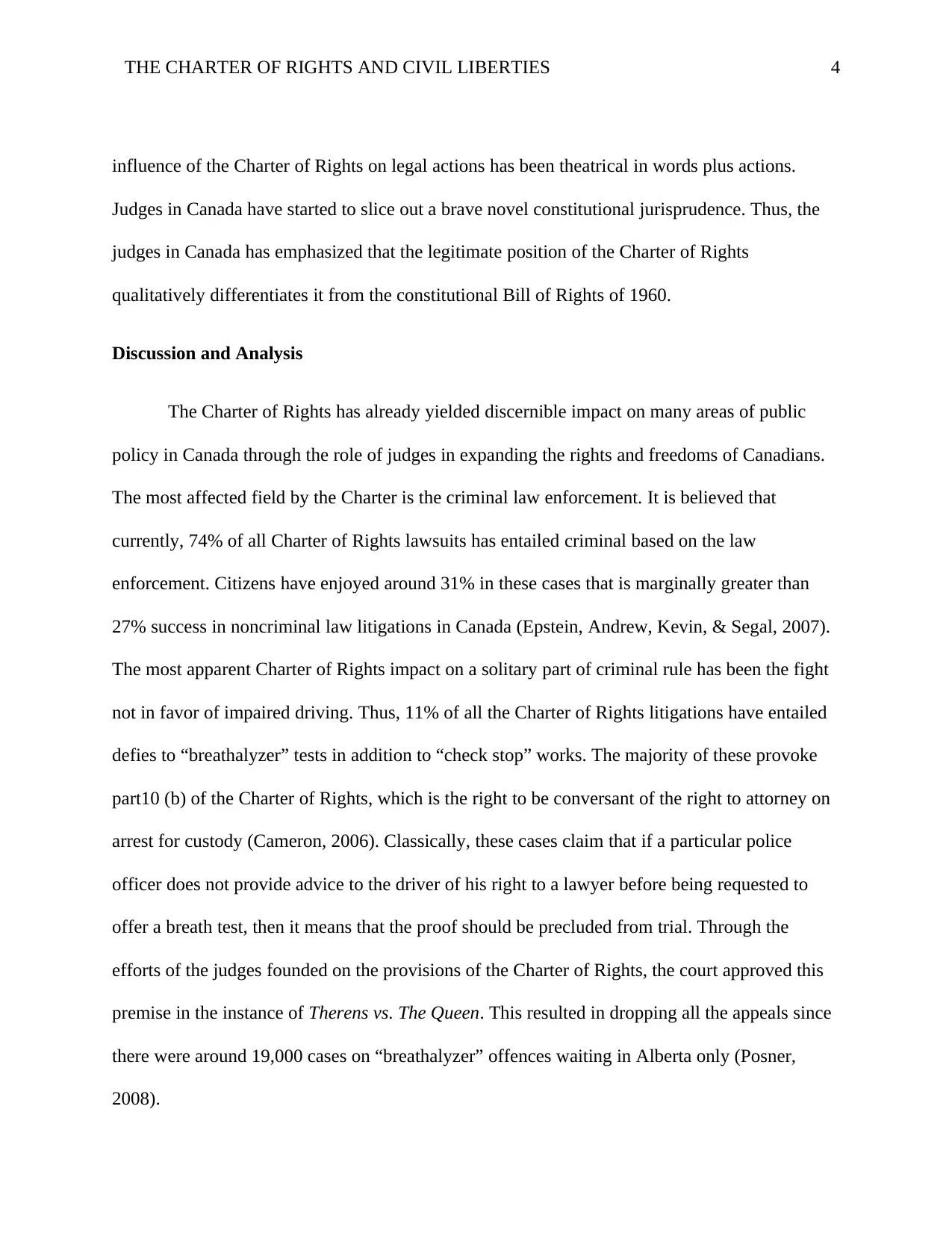
THE CHARTER OF RIGHTS AND CIVIL LIBERTIES 4
influence of the Charter of Rights on legal actions has been theatrical in words plus actions.
Judges in Canada have started to slice out a brave novel constitutional jurisprudence. Thus, the
judges in Canada has emphasized that the legitimate position of the Charter of Rights
qualitatively differentiates it from the constitutional Bill of Rights of 1960.
Discussion and Analysis
The Charter of Rights has already yielded discernible impact on many areas of public
policy in Canada through the role of judges in expanding the rights and freedoms of Canadians.
The most affected field by the Charter is the criminal law enforcement. It is believed that
currently, 74% of all Charter of Rights lawsuits has entailed criminal based on the law
enforcement. Citizens have enjoyed around 31% in these cases that is marginally greater than
27% success in noncriminal law litigations in Canada (Epstein, Andrew, Kevin, & Segal, 2007).
The most apparent Charter of Rights impact on a solitary part of criminal rule has been the fight
not in favor of impaired driving. Thus, 11% of all the Charter of Rights litigations have entailed
defies to “breathalyzer” tests in addition to “check stop” works. The majority of these provoke
part10 (b) of the Charter of Rights, which is the right to be conversant of the right to attorney on
arrest for custody (Cameron, 2006). Classically, these cases claim that if a particular police
officer does not provide advice to the driver of his right to a lawyer before being requested to
offer a breath test, then it means that the proof should be precluded from trial. Through the
efforts of the judges founded on the provisions of the Charter of Rights, the court approved this
premise in the instance of Therens vs. The Queen. This resulted in dropping all the appeals since
there were around 19,000 cases on “breathalyzer” offences waiting in Alberta only (Posner,
2008).
influence of the Charter of Rights on legal actions has been theatrical in words plus actions.
Judges in Canada have started to slice out a brave novel constitutional jurisprudence. Thus, the
judges in Canada has emphasized that the legitimate position of the Charter of Rights
qualitatively differentiates it from the constitutional Bill of Rights of 1960.
Discussion and Analysis
The Charter of Rights has already yielded discernible impact on many areas of public
policy in Canada through the role of judges in expanding the rights and freedoms of Canadians.
The most affected field by the Charter is the criminal law enforcement. It is believed that
currently, 74% of all Charter of Rights lawsuits has entailed criminal based on the law
enforcement. Citizens have enjoyed around 31% in these cases that is marginally greater than
27% success in noncriminal law litigations in Canada (Epstein, Andrew, Kevin, & Segal, 2007).
The most apparent Charter of Rights impact on a solitary part of criminal rule has been the fight
not in favor of impaired driving. Thus, 11% of all the Charter of Rights litigations have entailed
defies to “breathalyzer” tests in addition to “check stop” works. The majority of these provoke
part10 (b) of the Charter of Rights, which is the right to be conversant of the right to attorney on
arrest for custody (Cameron, 2006). Classically, these cases claim that if a particular police
officer does not provide advice to the driver of his right to a lawyer before being requested to
offer a breath test, then it means that the proof should be precluded from trial. Through the
efforts of the judges founded on the provisions of the Charter of Rights, the court approved this
premise in the instance of Therens vs. The Queen. This resulted in dropping all the appeals since
there were around 19,000 cases on “breathalyzer” offences waiting in Alberta only (Posner,
2008).
Paraphrase This Document
Need a fresh take? Get an instant paraphrase of this document with our AI Paraphraser
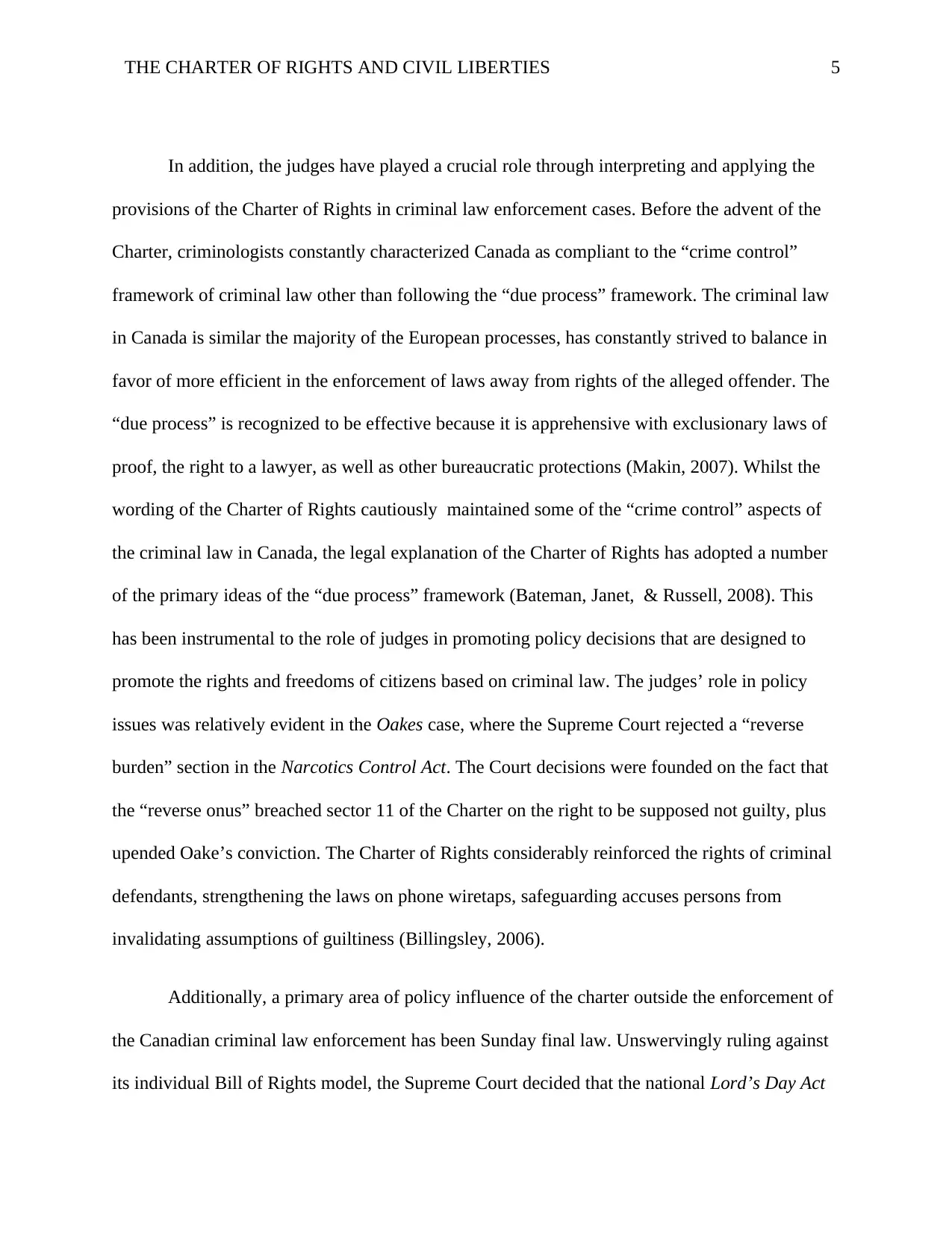
THE CHARTER OF RIGHTS AND CIVIL LIBERTIES 5
In addition, the judges have played a crucial role through interpreting and applying the
provisions of the Charter of Rights in criminal law enforcement cases. Before the advent of the
Charter, criminologists constantly characterized Canada as compliant to the “crime control”
framework of criminal law other than following the “due process” framework. The criminal law
in Canada is similar the majority of the European processes, has constantly strived to balance in
favor of more efficient in the enforcement of laws away from rights of the alleged offender. The
“due process” is recognized to be effective because it is apprehensive with exclusionary laws of
proof, the right to a lawyer, as well as other bureaucratic protections (Makin, 2007). Whilst the
wording of the Charter of Rights cautiously maintained some of the “crime control” aspects of
the criminal law in Canada, the legal explanation of the Charter of Rights has adopted a number
of the primary ideas of the “due process” framework (Bateman, Janet, & Russell, 2008). This
has been instrumental to the role of judges in promoting policy decisions that are designed to
promote the rights and freedoms of citizens based on criminal law. The judges’ role in policy
issues was relatively evident in the Oakes case, where the Supreme Court rejected a “reverse
burden” section in the Narcotics Control Act. The Court decisions were founded on the fact that
the “reverse onus” breached sector 11 of the Charter on the right to be supposed not guilty, plus
upended Oake’s conviction. The Charter of Rights considerably reinforced the rights of criminal
defendants, strengthening the laws on phone wiretaps, safeguarding accuses persons from
invalidating assumptions of guiltiness (Billingsley, 2006).
Additionally, a primary area of policy influence of the charter outside the enforcement of
the Canadian criminal law enforcement has been Sunday final law. Unswervingly ruling against
its individual Bill of Rights model, the Supreme Court decided that the national Lord’s Day Act
In addition, the judges have played a crucial role through interpreting and applying the
provisions of the Charter of Rights in criminal law enforcement cases. Before the advent of the
Charter, criminologists constantly characterized Canada as compliant to the “crime control”
framework of criminal law other than following the “due process” framework. The criminal law
in Canada is similar the majority of the European processes, has constantly strived to balance in
favor of more efficient in the enforcement of laws away from rights of the alleged offender. The
“due process” is recognized to be effective because it is apprehensive with exclusionary laws of
proof, the right to a lawyer, as well as other bureaucratic protections (Makin, 2007). Whilst the
wording of the Charter of Rights cautiously maintained some of the “crime control” aspects of
the criminal law in Canada, the legal explanation of the Charter of Rights has adopted a number
of the primary ideas of the “due process” framework (Bateman, Janet, & Russell, 2008). This
has been instrumental to the role of judges in promoting policy decisions that are designed to
promote the rights and freedoms of citizens based on criminal law. The judges’ role in policy
issues was relatively evident in the Oakes case, where the Supreme Court rejected a “reverse
burden” section in the Narcotics Control Act. The Court decisions were founded on the fact that
the “reverse onus” breached sector 11 of the Charter on the right to be supposed not guilty, plus
upended Oake’s conviction. The Charter of Rights considerably reinforced the rights of criminal
defendants, strengthening the laws on phone wiretaps, safeguarding accuses persons from
invalidating assumptions of guiltiness (Billingsley, 2006).
Additionally, a primary area of policy influence of the charter outside the enforcement of
the Canadian criminal law enforcement has been Sunday final law. Unswervingly ruling against
its individual Bill of Rights model, the Supreme Court decided that the national Lord’s Day Act
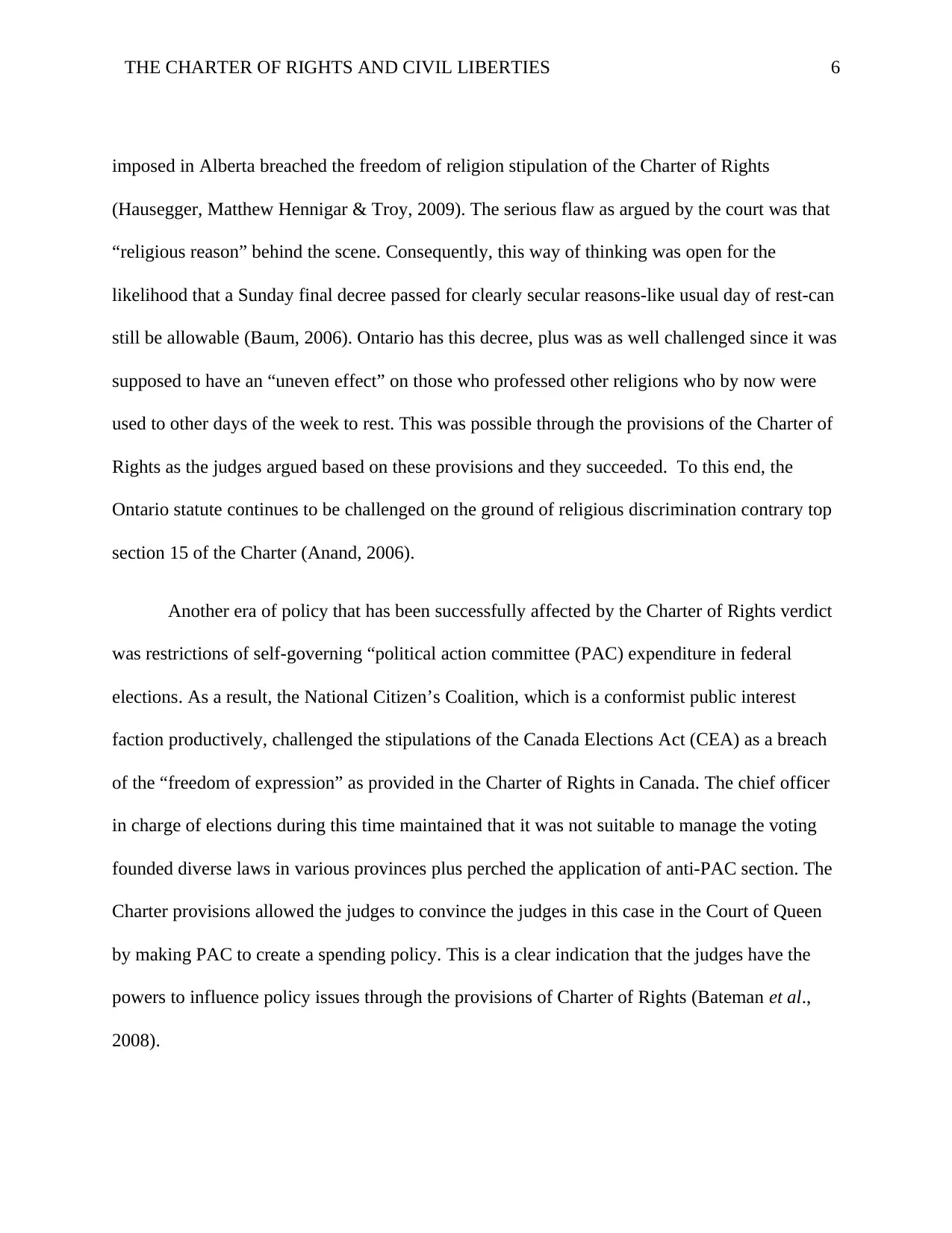
THE CHARTER OF RIGHTS AND CIVIL LIBERTIES 6
imposed in Alberta breached the freedom of religion stipulation of the Charter of Rights
(Hausegger, Matthew Hennigar & Troy, 2009). The serious flaw as argued by the court was that
“religious reason” behind the scene. Consequently, this way of thinking was open for the
likelihood that a Sunday final decree passed for clearly secular reasons-like usual day of rest-can
still be allowable (Baum, 2006). Ontario has this decree, plus was as well challenged since it was
supposed to have an “uneven effect” on those who professed other religions who by now were
used to other days of the week to rest. This was possible through the provisions of the Charter of
Rights as the judges argued based on these provisions and they succeeded. To this end, the
Ontario statute continues to be challenged on the ground of religious discrimination contrary top
section 15 of the Charter (Anand, 2006).
Another era of policy that has been successfully affected by the Charter of Rights verdict
was restrictions of self-governing “political action committee (PAC) expenditure in federal
elections. As a result, the National Citizen’s Coalition, which is a conformist public interest
faction productively, challenged the stipulations of the Canada Elections Act (CEA) as a breach
of the “freedom of expression” as provided in the Charter of Rights in Canada. The chief officer
in charge of elections during this time maintained that it was not suitable to manage the voting
founded diverse laws in various provinces plus perched the application of anti-PAC section. The
Charter provisions allowed the judges to convince the judges in this case in the Court of Queen
by making PAC to create a spending policy. This is a clear indication that the judges have the
powers to influence policy issues through the provisions of Charter of Rights (Bateman et al.,
2008).
imposed in Alberta breached the freedom of religion stipulation of the Charter of Rights
(Hausegger, Matthew Hennigar & Troy, 2009). The serious flaw as argued by the court was that
“religious reason” behind the scene. Consequently, this way of thinking was open for the
likelihood that a Sunday final decree passed for clearly secular reasons-like usual day of rest-can
still be allowable (Baum, 2006). Ontario has this decree, plus was as well challenged since it was
supposed to have an “uneven effect” on those who professed other religions who by now were
used to other days of the week to rest. This was possible through the provisions of the Charter of
Rights as the judges argued based on these provisions and they succeeded. To this end, the
Ontario statute continues to be challenged on the ground of religious discrimination contrary top
section 15 of the Charter (Anand, 2006).
Another era of policy that has been successfully affected by the Charter of Rights verdict
was restrictions of self-governing “political action committee (PAC) expenditure in federal
elections. As a result, the National Citizen’s Coalition, which is a conformist public interest
faction productively, challenged the stipulations of the Canada Elections Act (CEA) as a breach
of the “freedom of expression” as provided in the Charter of Rights in Canada. The chief officer
in charge of elections during this time maintained that it was not suitable to manage the voting
founded diverse laws in various provinces plus perched the application of anti-PAC section. The
Charter provisions allowed the judges to convince the judges in this case in the Court of Queen
by making PAC to create a spending policy. This is a clear indication that the judges have the
powers to influence policy issues through the provisions of Charter of Rights (Bateman et al.,
2008).
⊘ This is a preview!⊘
Do you want full access?
Subscribe today to unlock all pages.

Trusted by 1+ million students worldwide
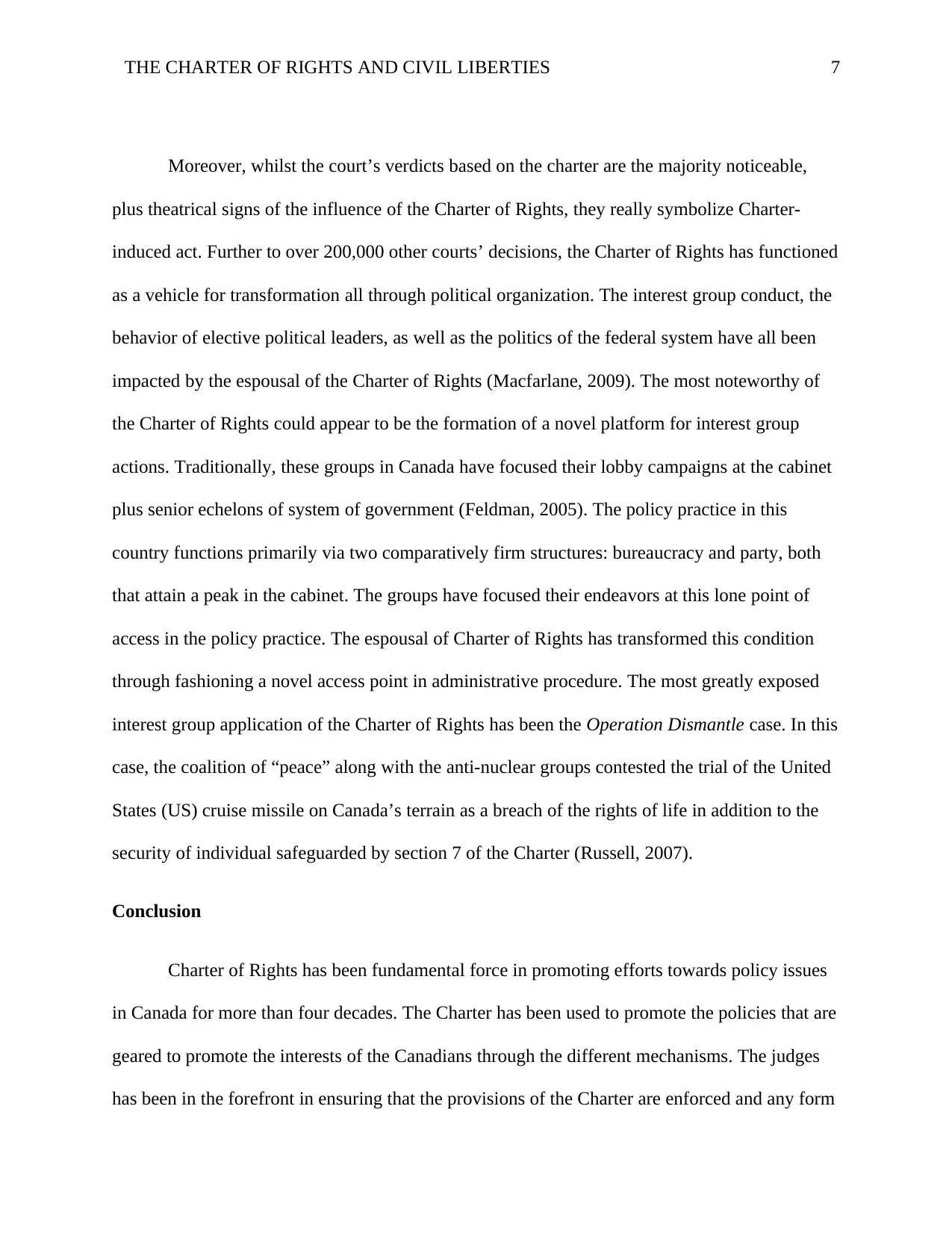
THE CHARTER OF RIGHTS AND CIVIL LIBERTIES 7
Moreover, whilst the court’s verdicts based on the charter are the majority noticeable,
plus theatrical signs of the influence of the Charter of Rights, they really symbolize Charter-
induced act. Further to over 200,000 other courts’ decisions, the Charter of Rights has functioned
as a vehicle for transformation all through political organization. The interest group conduct, the
behavior of elective political leaders, as well as the politics of the federal system have all been
impacted by the espousal of the Charter of Rights (Macfarlane, 2009). The most noteworthy of
the Charter of Rights could appear to be the formation of a novel platform for interest group
actions. Traditionally, these groups in Canada have focused their lobby campaigns at the cabinet
plus senior echelons of system of government (Feldman, 2005). The policy practice in this
country functions primarily via two comparatively firm structures: bureaucracy and party, both
that attain a peak in the cabinet. The groups have focused their endeavors at this lone point of
access in the policy practice. The espousal of Charter of Rights has transformed this condition
through fashioning a novel access point in administrative procedure. The most greatly exposed
interest group application of the Charter of Rights has been the Operation Dismantle case. In this
case, the coalition of “peace” along with the anti-nuclear groups contested the trial of the United
States (US) cruise missile on Canada’s terrain as a breach of the rights of life in addition to the
security of individual safeguarded by section 7 of the Charter (Russell, 2007).
Conclusion
Charter of Rights has been fundamental force in promoting efforts towards policy issues
in Canada for more than four decades. The Charter has been used to promote the policies that are
geared to promote the interests of the Canadians through the different mechanisms. The judges
has been in the forefront in ensuring that the provisions of the Charter are enforced and any form
Moreover, whilst the court’s verdicts based on the charter are the majority noticeable,
plus theatrical signs of the influence of the Charter of Rights, they really symbolize Charter-
induced act. Further to over 200,000 other courts’ decisions, the Charter of Rights has functioned
as a vehicle for transformation all through political organization. The interest group conduct, the
behavior of elective political leaders, as well as the politics of the federal system have all been
impacted by the espousal of the Charter of Rights (Macfarlane, 2009). The most noteworthy of
the Charter of Rights could appear to be the formation of a novel platform for interest group
actions. Traditionally, these groups in Canada have focused their lobby campaigns at the cabinet
plus senior echelons of system of government (Feldman, 2005). The policy practice in this
country functions primarily via two comparatively firm structures: bureaucracy and party, both
that attain a peak in the cabinet. The groups have focused their endeavors at this lone point of
access in the policy practice. The espousal of Charter of Rights has transformed this condition
through fashioning a novel access point in administrative procedure. The most greatly exposed
interest group application of the Charter of Rights has been the Operation Dismantle case. In this
case, the coalition of “peace” along with the anti-nuclear groups contested the trial of the United
States (US) cruise missile on Canada’s terrain as a breach of the rights of life in addition to the
security of individual safeguarded by section 7 of the Charter (Russell, 2007).
Conclusion
Charter of Rights has been fundamental force in promoting efforts towards policy issues
in Canada for more than four decades. The Charter has been used to promote the policies that are
geared to promote the interests of the Canadians through the different mechanisms. The judges
has been in the forefront in ensuring that the provisions of the Charter are enforced and any form
Paraphrase This Document
Need a fresh take? Get an instant paraphrase of this document with our AI Paraphraser
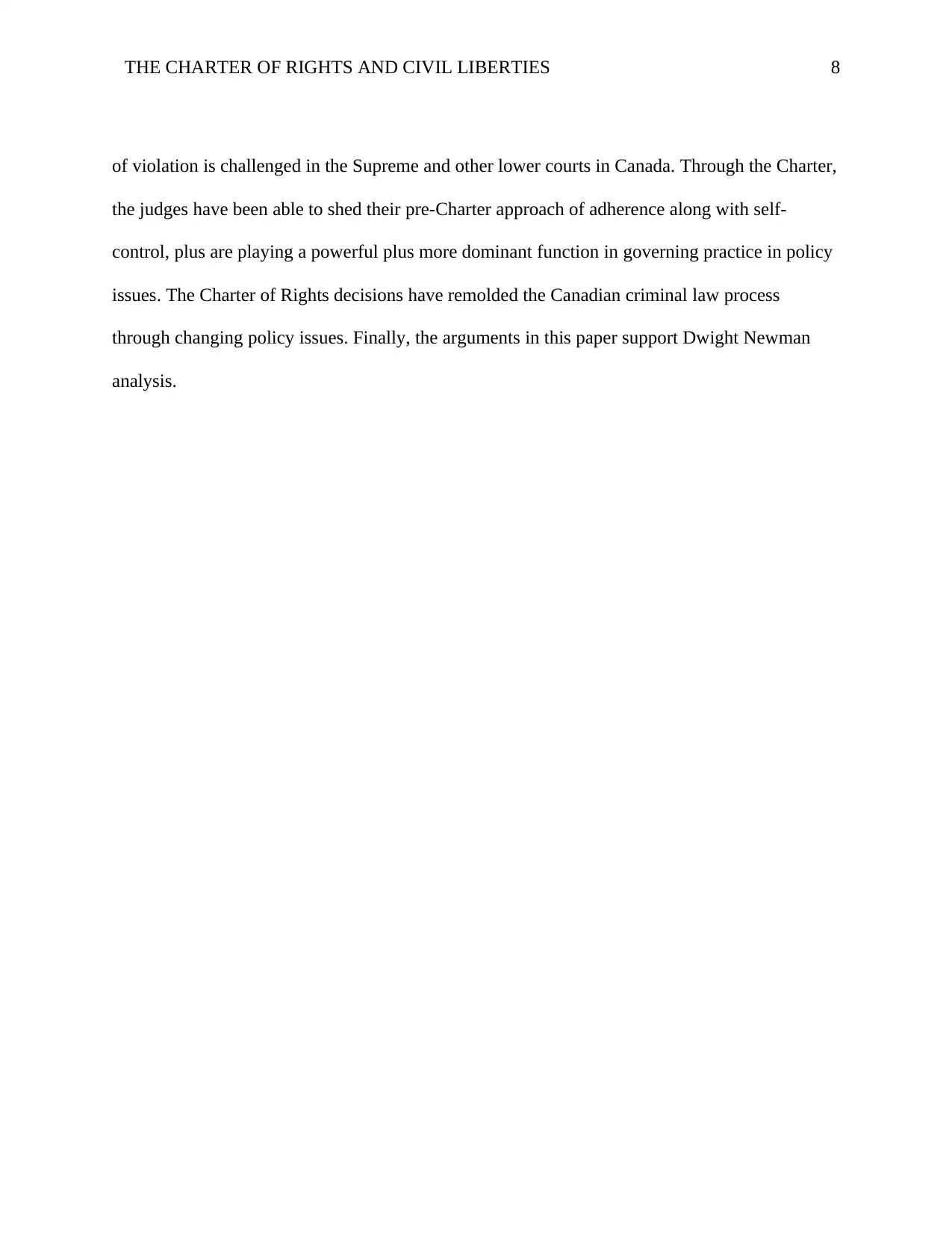
THE CHARTER OF RIGHTS AND CIVIL LIBERTIES 8
of violation is challenged in the Supreme and other lower courts in Canada. Through the Charter,
the judges have been able to shed their pre-Charter approach of adherence along with self-
control, plus are playing a powerful plus more dominant function in governing practice in policy
issues. The Charter of Rights decisions have remolded the Canadian criminal law process
through changing policy issues. Finally, the arguments in this paper support Dwight Newman
analysis.
of violation is challenged in the Supreme and other lower courts in Canada. Through the Charter,
the judges have been able to shed their pre-Charter approach of adherence along with self-
control, plus are playing a powerful plus more dominant function in governing practice in policy
issues. The Charter of Rights decisions have remolded the Canadian criminal law process
through changing policy issues. Finally, the arguments in this paper support Dwight Newman
analysis.
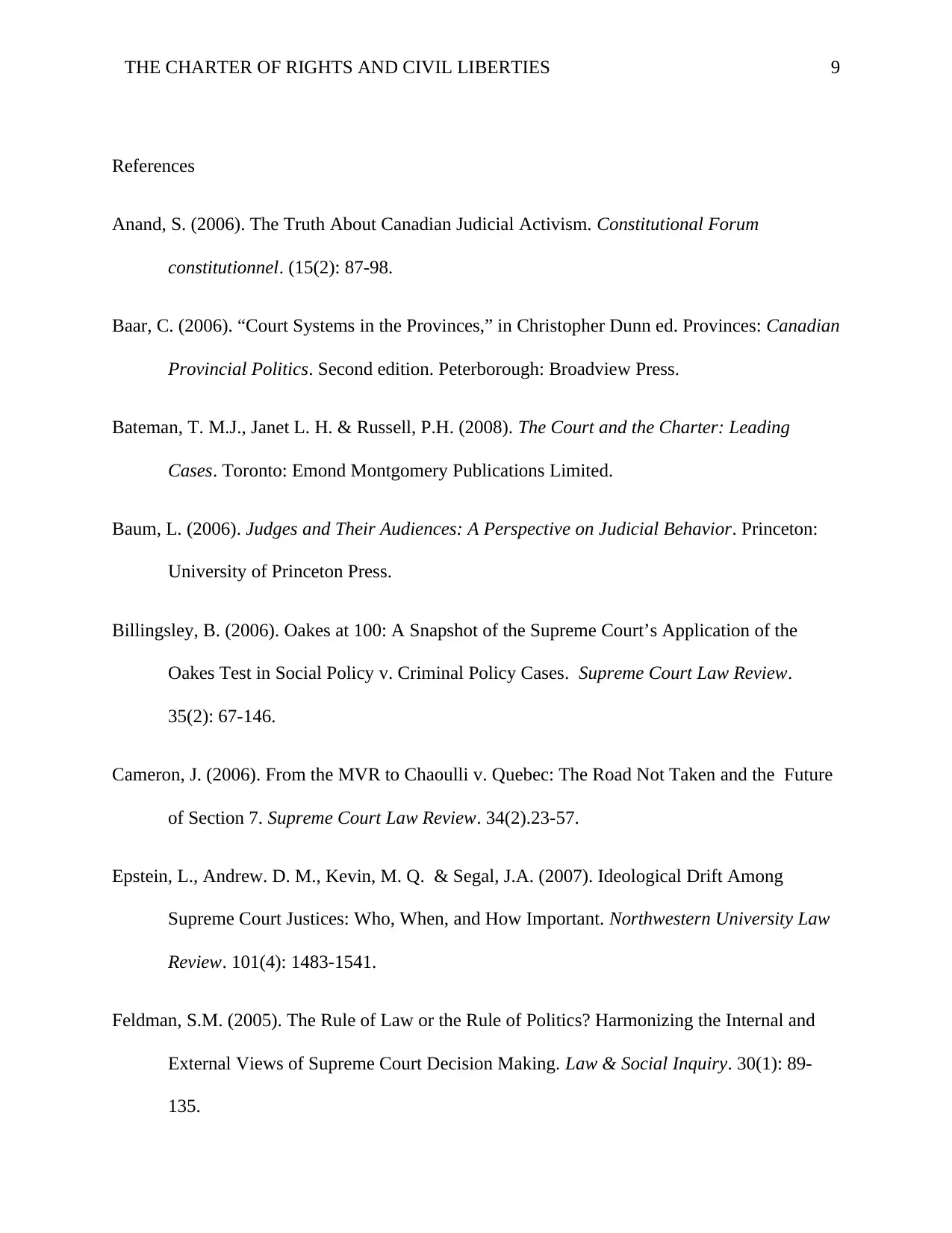
THE CHARTER OF RIGHTS AND CIVIL LIBERTIES 9
References
Anand, S. (2006). The Truth About Canadian Judicial Activism. Constitutional Forum
constitutionnel. (15(2): 87-98.
Baar, C. (2006). “Court Systems in the Provinces,” in Christopher Dunn ed. Provinces: Canadian
Provincial Politics. Second edition. Peterborough: Broadview Press.
Bateman, T. M.J., Janet L. H. & Russell, P.H. (2008). The Court and the Charter: Leading
Cases. Toronto: Emond Montgomery Publications Limited.
Baum, L. (2006). Judges and Their Audiences: A Perspective on Judicial Behavior. Princeton:
University of Princeton Press.
Billingsley, B. (2006). Oakes at 100: A Snapshot of the Supreme Court’s Application of the
Oakes Test in Social Policy v. Criminal Policy Cases. Supreme Court Law Review.
35(2): 67-146.
Cameron, J. (2006). From the MVR to Chaoulli v. Quebec: The Road Not Taken and the Future
of Section 7. Supreme Court Law Review. 34(2).23-57.
Epstein, L., Andrew. D. M., Kevin, M. Q. & Segal, J.A. (2007). Ideological Drift Among
Supreme Court Justices: Who, When, and How Important. Northwestern University Law
Review. 101(4): 1483-1541.
Feldman, S.M. (2005). The Rule of Law or the Rule of Politics? Harmonizing the Internal and
External Views of Supreme Court Decision Making. Law & Social Inquiry. 30(1): 89-
135.
References
Anand, S. (2006). The Truth About Canadian Judicial Activism. Constitutional Forum
constitutionnel. (15(2): 87-98.
Baar, C. (2006). “Court Systems in the Provinces,” in Christopher Dunn ed. Provinces: Canadian
Provincial Politics. Second edition. Peterborough: Broadview Press.
Bateman, T. M.J., Janet L. H. & Russell, P.H. (2008). The Court and the Charter: Leading
Cases. Toronto: Emond Montgomery Publications Limited.
Baum, L. (2006). Judges and Their Audiences: A Perspective on Judicial Behavior. Princeton:
University of Princeton Press.
Billingsley, B. (2006). Oakes at 100: A Snapshot of the Supreme Court’s Application of the
Oakes Test in Social Policy v. Criminal Policy Cases. Supreme Court Law Review.
35(2): 67-146.
Cameron, J. (2006). From the MVR to Chaoulli v. Quebec: The Road Not Taken and the Future
of Section 7. Supreme Court Law Review. 34(2).23-57.
Epstein, L., Andrew. D. M., Kevin, M. Q. & Segal, J.A. (2007). Ideological Drift Among
Supreme Court Justices: Who, When, and How Important. Northwestern University Law
Review. 101(4): 1483-1541.
Feldman, S.M. (2005). The Rule of Law or the Rule of Politics? Harmonizing the Internal and
External Views of Supreme Court Decision Making. Law & Social Inquiry. 30(1): 89-
135.
⊘ This is a preview!⊘
Do you want full access?
Subscribe today to unlock all pages.

Trusted by 1+ million students worldwide
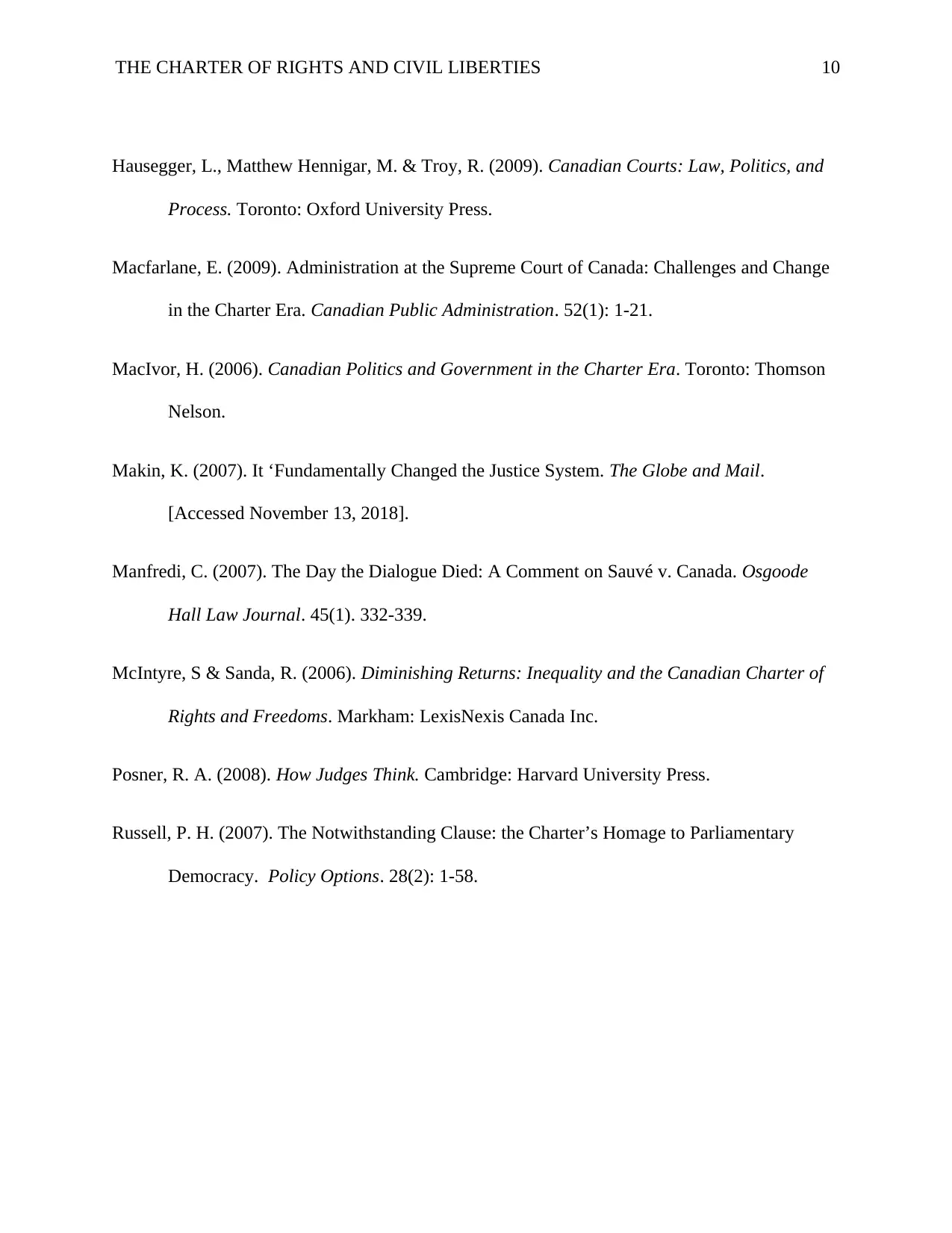
THE CHARTER OF RIGHTS AND CIVIL LIBERTIES 10
Hausegger, L., Matthew Hennigar, M. & Troy, R. (2009). Canadian Courts: Law, Politics, and
Process. Toronto: Oxford University Press.
Macfarlane, E. (2009). Administration at the Supreme Court of Canada: Challenges and Change
in the Charter Era. Canadian Public Administration. 52(1): 1-21.
MacIvor, H. (2006). Canadian Politics and Government in the Charter Era. Toronto: Thomson
Nelson.
Makin, K. (2007). It ‘Fundamentally Changed the Justice System. The Globe and Mail.
[Accessed November 13, 2018].
Manfredi, C. (2007). The Day the Dialogue Died: A Comment on Sauvé v. Canada. Osgoode
Hall Law Journal. 45(1). 332-339.
McIntyre, S & Sanda, R. (2006). Diminishing Returns: Inequality and the Canadian Charter of
Rights and Freedoms. Markham: LexisNexis Canada Inc.
Posner, R. A. (2008). How Judges Think. Cambridge: Harvard University Press.
Russell, P. H. (2007). The Notwithstanding Clause: the Charter’s Homage to Parliamentary
Democracy. Policy Options. 28(2): 1-58.
Hausegger, L., Matthew Hennigar, M. & Troy, R. (2009). Canadian Courts: Law, Politics, and
Process. Toronto: Oxford University Press.
Macfarlane, E. (2009). Administration at the Supreme Court of Canada: Challenges and Change
in the Charter Era. Canadian Public Administration. 52(1): 1-21.
MacIvor, H. (2006). Canadian Politics and Government in the Charter Era. Toronto: Thomson
Nelson.
Makin, K. (2007). It ‘Fundamentally Changed the Justice System. The Globe and Mail.
[Accessed November 13, 2018].
Manfredi, C. (2007). The Day the Dialogue Died: A Comment on Sauvé v. Canada. Osgoode
Hall Law Journal. 45(1). 332-339.
McIntyre, S & Sanda, R. (2006). Diminishing Returns: Inequality and the Canadian Charter of
Rights and Freedoms. Markham: LexisNexis Canada Inc.
Posner, R. A. (2008). How Judges Think. Cambridge: Harvard University Press.
Russell, P. H. (2007). The Notwithstanding Clause: the Charter’s Homage to Parliamentary
Democracy. Policy Options. 28(2): 1-58.
Paraphrase This Document
Need a fresh take? Get an instant paraphrase of this document with our AI Paraphraser
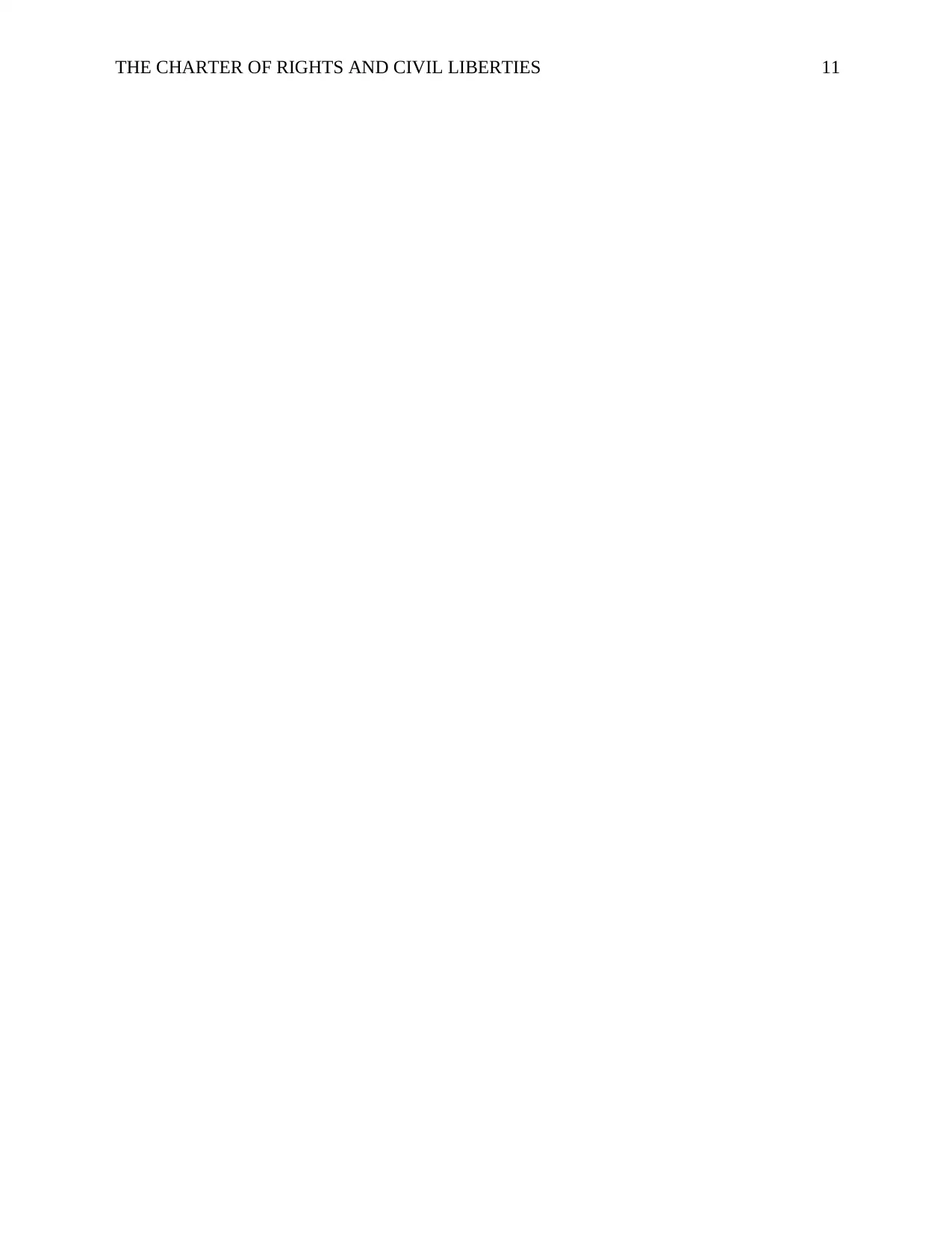
THE CHARTER OF RIGHTS AND CIVIL LIBERTIES 11
1 out of 11
Related Documents
Your All-in-One AI-Powered Toolkit for Academic Success.
+13062052269
info@desklib.com
Available 24*7 on WhatsApp / Email
![[object Object]](/_next/static/media/star-bottom.7253800d.svg)
Unlock your academic potential
Copyright © 2020–2025 A2Z Services. All Rights Reserved. Developed and managed by ZUCOL.




